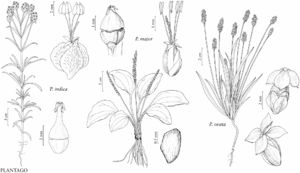Plantago ovata
Fl. Aegypt.-Arab., 31. 1775.
Annuals; roots taproots, slender. Stems 0–30 mm, often branched. Leaves 10–230 × 0.5–12 mm; blade linear or narrowly elliptic, margins toothed, veins conspicuous or not, surfaces villous or lanate to sericeous. Scapes 10–400 mm, hairy, hairs woolly, long. Spikes grayish or brownish, 20–400 mm, densely flowered, flowers in spirals; bracts ovate or elliptic, 1.7–4 mm, length 0.8–1.2 times sepals, apex not reached by green nerve. Flowers: sepals 1.9–3.5 mm; corolla radially symmetric, lobes reflexed, 1.3–2.8 mm, base cuneate; stamens 4. Seeds 2, 2–2.6 mm. 2n = 8.
Phenology: Flowering spring.
Habitat: Sandy deserts and steppes.
Elevation: 0–1800 m.
Distribution
Ariz., Calif., Nev., Tex., Utah, Mexico (Baja California), Mexico (Sonora), Eurasia, Africa
Discussion
From molecular evidence, S. C. Meyers and A. Liston (2008) suggested that Plantago ovata was introduced to North America during the Pleistocene. They recognized four varieties; North American specimens can be treated as two varieties based on bract and corolla color: the inland var. fastigiata (E. Morris) S. C. Meyers & Liston (midribs of mature flower bracts green, corolla lobes without reddish brown midribs) and the coastal var. insularis (Eastwood) S. C. Meyers & Liston (midribs of mature flower bracts brown, corolla lobe midribs prominent, reddish brown). Unfortunately, these features are not easily seen on many herbarium specimens, and these taxa are not recognized here.
Selected References
Lower Taxa
"-1.2timessepals" is not declared as a valid unit of measurement for this property.
